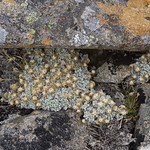
Diselma archeri is a species of plant of the family Cupressaceae and the sole species in the genus Diselma. It is endemic to the alpine regions of Tasmania's southwest and Central Highlands, on the western coast ranges and Lake St. Clair. It is a monotypic genus restricted to high altitude rainforest and moist alpine heathland. Its distribution mirrors very closely that of other endemic Tasmanian conifers Microcachrys tetragona and Pherosphaera hookeriana.

A cushion plant is a compact, low-growing, mat-forming plant that is found in alpine, subalpine, arctic, or subarctic environments around the world. The term "cushion" is usually applied to woody plants that grow as spreading mats, are limited in height above the ground, have relatively large and deep tap roots, and have life histories adapted to slow growth in a nutrient-poor environment with delayed reproductivity and reproductive cycle adaptations. The plant form is an example of parallel or convergent evolution with species from many different plant families on different continents converging on the same evolutionary adaptations to endure the harsh environmental conditions.

Goodenia montana, commonly known as mountain velleia, is a flowering plant in the family Goodeniaceae. It is a small, perennial herb with lance-shaped to egg-shaped leaves with the narrower end towards the base, and yellow flowers. It mainly grows in woodland and sub-alpine grasslands in New South Wales, Victoria and Tasmania.

Pterygopappus is a genus of flowering plants in the tribe Gnaphalieae within the family Asteraceae. There is only one known species, Pterygopappus lawrencii, which is endemic to alpine Tasmania. It forms thick, light blue/green mats with densely packed leaves. It is most common in the mountains of the northeastern part of the island. It is a slow grower and prefers cool, moist environments.
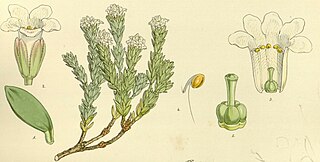
Archeria serpyllifolia is a dense, compact, low growing shrub, that is endemic to Tasmania, Australia, inhabiting the undisturbed alpine areas of southern and south-west Tasmania. This plant is commonly referred to by Australasian naturalists as thyme archeria.

Gleichenia alpina, commonly known as alpine coral-fern, is a small fern species that occurs in Tasmania and New Zealand. It grows in alpine and subalpine areas with moist soils and is a part of the Gleichrniaceae family.

Monotoca scoparia, commonly known as prickly broom heath, is a widespread native species across south-eastern Australia. Monotoca scoparia was formerly in the family Epacridaceae but now belongs to the family Ericaceae. Monotoca is an endemic Australian genus with 17 described species occurring in all states.

Tasmanian cushion plants are low growing, highly compact, woody, spreading mats that can grow up to 3 m in diameter, located mainly on the island of Tasmania. These mats are made up of tightly packed stems that grow at the same rate so that no apical rosettes protrude above the rest. The term cushion plant refers to a characteristic growth habit adopted by various species from a range of families to adapt to alpine and subalpine environments and areas of high latitude. They are adapted to grow in low nutrient areas and typically have deep taproots. Cushion plants are very slow growing and do not grow high above ground; mounds typically remain under 30 cm high. Underneath the living surface of the cushion, the plants either allow dead leaves to persist or produce non-photosynthetic material, resulting in an insulating effect.
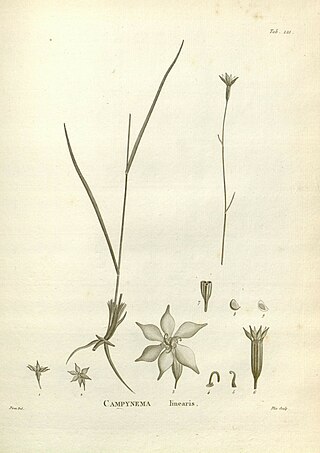
Campynema is a genus in the family Campynemataceae first described in 1805. It contains only one known species (monotypic), Campynema lineare, endemic to the island of Tasmania in Australia. Its closest relative is Campynemanthe, endemic to New Caledonia, sole other genus of the family.

Abrotanella forsteroides, commonly known as the Tasmanian cushion plant, is an angiosperm endemic to Tasmania, Australia. The plant is a dicot species in the daisy family Asteraceae and can be identified by its bright green and compact cushion like appearance.

Abrotanella scapigera is an endemic angiosperm of Tasmania, Australia. It is a member of the family Asteraceae, commonly found in alpine regions of northwest and south-central Tasmania. This species is named after its characteristic sparsely leaved flowering stem that distinguishes it from the other 18 species of the Genus.

Olearia ledifolia, commonly known as rock daisy bush, is a species of flowering plant of the family Asteraceae. It is endemic to Tasmania and found at higher altitudes where it grows as a low, compact bush with tough, leathery leaves and small white and yellow daisy-like "flowers" in summer.
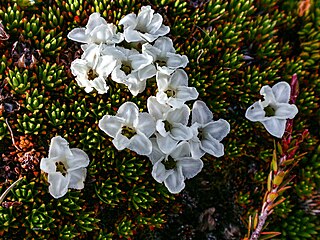
Dracophyllum minimum, commonly known as heath cushionplant or claspleaf heath, is a species of bolster cushion plant endemic to Tasmania, Australia. It is a low growing, highly compacted plant with white flowers, commonly found in alpine areas of the south, centre and west of Tasmania.

Oreobolus pumilio, commonly known as alpine tuftrush or Ibrang`rank, is a small mat forming herb which is distributed throughout the Australasian region. It is a relative of the sedge. It is often found in cushion plant communities, in alpine environments, where it is a dominant species. As a cushion plant, it is an ecological engineer and enables other species to grow in the alpine herblands to which it is native to.

Ewartia meredithiae, commonly known as the rusty cushion plant, is a Tasmanian endemic cushion plant species. Out of the four species in Australia from this small genus, Tasmania has three, all of which are low growing, alpine species.
Euphrasia striata, commonly known as ‘shiny striped eyebright’ is an endemic Tasmanian species, which is a member of the Scrophulariaceae family. The distinctive purple striations on the petals, from which the name was derived, are characteristic of the species.
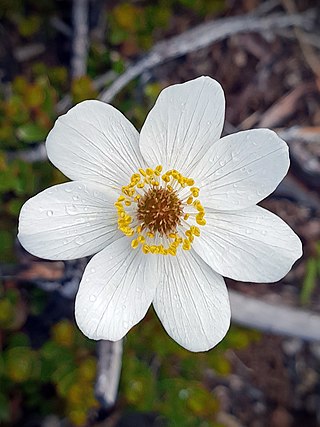
Anemone crassifolia, commonly known as mountain anemone, is a perennial herb in the family Ranunculaceae and is endemic to Tasmania, Australia. The species is common in high alpine moorlands of western and southern Tasmania at approximately 1000m. It is the only representative of the genus Anemone found in Australia.
Celmisia saxifraga, commonly known as the small snow daisy, is a perennial herb in the Asteraceae family. It is native to Tasmania and Victoria, where it grows in alpine grasslands above the snowline.
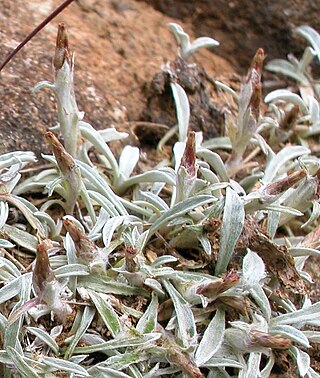
Euchiton traversii, commonly known as mat cudweed, is a small, woolly, alpine rosette herb. It forms a mat-like habit, hence the common name, in alpine wet heath and grasslands. The species is found in Australia—in Tasmania, Victoria, New South Wales, Australian Capital Territory—and the North and South Islands of New Zealand.

Diplaspis cordifolia is an endemic Tasmanian herb, known commonly as western mountain-pennywort. It is found in alpine vegetation communities across Tasmania, most commonly in the West and South-western areas.
1.^ HCM Cushion moorland: western facies, 2016 Tasmanian Vegetation Monitoring and Mapping Program- TASVEG, Retrieved 21 March 2020
3.^ Jordan, Greg. "Key to Tasmanian Dicots". Key to Tasmanian Dicots. University of Tasmania. Retrieved 21 March 2020
4.^ Flora of Australia, Volume 37, Asteraceae 1, 2015, pp. 29 Retrieved 21 March 2020
6.^ Wiltshire, Robert (c. 2010). Field Botany. School of Natural Sciences, University of Tasmania. pp.62- 71
7.^ "Potential Impacts of Climate Change on Tasmania’s Terrestrial and Marine Biodiversity and Natural Systems", 2008, Department of Primary Industries and Water Resource Management and Conservation, pp 28- 31 Retrieved 21 March 2020


